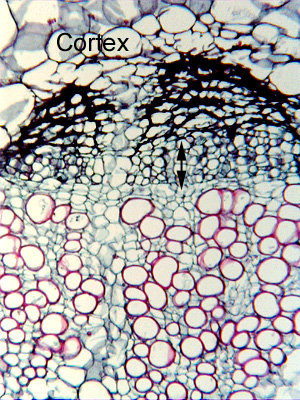 Fig.
16.2-4. Transverse section of a cactus (Espostoa mirabilis).
This cactus has very parenchymatous wood and just a small amount of phloem. The
double-headed arrow indicates the active
phloem, the phloem produced and conducting in the year the specimen
was collected. Above the active phloem in the micrograph (exterior to it in the
plant) is the collapsed
phloem: the darkly stained, almost black streaks are bands of
collapsed sieve tube members and companion cells. The white areas among the dark
streaks are cells of non-conducting parenchyma: they are parenchyma cells that
are neither sieve tube members nor companion cells, so they have not collapsed.
Fig.
16.2-4. Transverse section of a cactus (Espostoa mirabilis).
This cactus has very parenchymatous wood and just a small amount of phloem. The
double-headed arrow indicates the active
phloem, the phloem produced and conducting in the year the specimen
was collected. Above the active phloem in the micrograph (exterior to it in the
plant) is the collapsed
phloem: the darkly stained, almost black streaks are bands of
collapsed sieve tube members and companion cells. The white areas among the dark
streaks are cells of non-conducting parenchyma: they are parenchyma cells that
are neither sieve tube members nor companion cells, so they have not collapsed.
All cacti produce so little phloem that it does not accumulate to large enough masses to push the cortex outward far enough to rupture: almost all plants other than cacti soon shed their cortex, but cacti retain their cortex throughout their entire life.
You can read more about the anatomy of this unusual cactus and its relatives in the article: Mauseth, J. D. 1999. Comparative anatomy of Espostoa, Pseudoespostoa, Thrixanthocereus and Vatricania (Cactaceae). Bradleya vol. 17, pages 27 to 37.